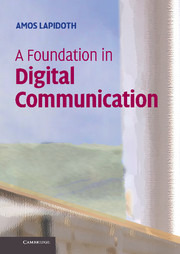Book contents
- Frontmatter
- Contents
- Preface
- Acknowledgments
- 1 Some Essential Notation
- 2 Signals, Integrals, and Sets of Measure Zero
- 3 The Inner Product
- 4 The Space L2 of Energy-Limited Signals
- 5 Convolutions and Filters
- 6 The Frequency Response of Filters and Bandlimited Signals
- 7 Passband Signals and Their Representation
- 8 Complete Orthonormal Systems and the Sampling Theorem
- 9 Sampling Real Passband Signals
- 10 Mapping Bits to Waveforms
- 11 Nyquist's Criterion
- 12 Stochastic Processes: Definition
- 13 Stationary Discrete-Time Stochastic Processes
- 14 Energy and Power in PAM
- 15 Operational Power Spectral Density
- 16 Quadrature Amplitude Modulation
- 17 Complex Random Variables and Processes
- 18 Energy, Power, and PSD in QAM
- 19 The Univariate Gaussian Distribution
- 20 Binary Hypothesis Testing
- 21 Multi-Hypothesis Testing
- 22 Sufficient Statistics
- 23 The Multivariate Gaussian Distribution
- 24 Complex Gaussians and Circular Symmetry
- 25 Continuous-Time Stochastic Processes
- 26 Detection in White Gaussian Noise
- 27 Noncoherent Detection and Nuisance Parameters
- 28 Detecting PAM and QAM Signals in White Gaussian Noise
- 29 Linear Binary Block Codes with Antipodal Signaling
- A On the Fourier Series
- Bibliography
- Theorems Referenced by Name
- Abbreviations
- List of Symbols
- Index
15 - Operational Power Spectral Density
Published online by Cambridge University Press: 05 June 2012
- Frontmatter
- Contents
- Preface
- Acknowledgments
- 1 Some Essential Notation
- 2 Signals, Integrals, and Sets of Measure Zero
- 3 The Inner Product
- 4 The Space L2 of Energy-Limited Signals
- 5 Convolutions and Filters
- 6 The Frequency Response of Filters and Bandlimited Signals
- 7 Passband Signals and Their Representation
- 8 Complete Orthonormal Systems and the Sampling Theorem
- 9 Sampling Real Passband Signals
- 10 Mapping Bits to Waveforms
- 11 Nyquist's Criterion
- 12 Stochastic Processes: Definition
- 13 Stationary Discrete-Time Stochastic Processes
- 14 Energy and Power in PAM
- 15 Operational Power Spectral Density
- 16 Quadrature Amplitude Modulation
- 17 Complex Random Variables and Processes
- 18 Energy, Power, and PSD in QAM
- 19 The Univariate Gaussian Distribution
- 20 Binary Hypothesis Testing
- 21 Multi-Hypothesis Testing
- 22 Sufficient Statistics
- 23 The Multivariate Gaussian Distribution
- 24 Complex Gaussians and Circular Symmetry
- 25 Continuous-Time Stochastic Processes
- 26 Detection in White Gaussian Noise
- 27 Noncoherent Detection and Nuisance Parameters
- 28 Detecting PAM and QAM Signals in White Gaussian Noise
- 29 Linear Binary Block Codes with Antipodal Signaling
- A On the Fourier Series
- Bibliography
- Theorems Referenced by Name
- Abbreviations
- List of Symbols
- Index
Summary
Introduction
The Power Spectral Density of a stochastic process tells us more about the SP than just its power. It tells us something about how this power is distributed among the different frequencies that the SP occupies. The purpose of this chapter is to clarify this statement and to derive the PSD of PAM signals. Most of this chapter is written informally with an emphasis on ideas and intuition as opposed to mathematical rigor. The mathematically-inclined readers will find precise statements of the key results of this chapter in Section 15.5. We emphasize that this chapter only deals with real continuous-time stochastic processes.
The classical definition of the PSD of continuous-time stochastic processes (Definition 25.7.2 ahead) is only applicable to wide-sense stationary stochastic processes, and PAM signals are not WSS. Consequently, we shall have to introduce a new concept, which we call the operational power spectral density, or the operational PSD for short. This new concept is applicable to a large family of stochastic processes that includes most WSS processes and most PAM signals. For WSS stochastic processes, the operational PSD and the classical PSD coincide (Section 25.14). In addition to being more general, the operational PSD is more intuitive in that it clarifies the origin of the words “power spectral density.” Moreover, it gives an operational meaning to the concept.
- Type
- Chapter
- Information
- A Foundation in Digital Communication , pp. 245 - 264Publisher: Cambridge University PressPrint publication year: 2009



